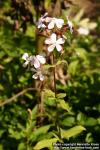
 The root and leaves of Saponaria officinalis, Linné.
The root and leaves of Saponaria officinalis, Linné.
Nat. Ord.—Caryophyllaceae.
COMMON NAMES: Soapwort, Soaproot, Bouncing Bet, Fuller's-herb.
Botanical Source.—This is a stout, perennial herbaceous plant, sometimes known by the name of Bouncing Bet, with a stem 1 to 2 feet in height. The leaves are lanceolate, inclining to elliptical, very acute, smooth, 2 or 3 inches long, and about one-third as wide. The flowers are many, large, flesh-colored or pale pink, often double, and borne in paniculate fascicles. Calyx cylindrical and slightly downy. Petals 5, and unguiculate; crowns of the petals linear. Stamens 10; styles 2; capsule oblong and 1-celled (G.—W.).
Description and Chemical Composition.—Soapwort is found growing in Europe and the United States, by roadsides and in waste places, flowering in July and August. The parts used medicinally are the root and leaves; they are without odor, and of a bitterish, slightly saccharine taste, with a subsequent persistent pungency and a benumbing sensation. With water they become frothy, like soap-suds; water or alcohol extracts their active properties. The active principle of this root was discovered in 1808 by J. C. C. Schrader, who named it saponin, and obtained it by extracting the powdered root with boiling alcohol and allowing to crystallize. Closely allied substances have since been found in the roots of Polygala Senega, Gypsophila Arrostii (not Struthium; see Flückiger, Archiv der Pharm., 1890, p. 192), in the barks of Quillaja Saponaria and Chrysophyllum glycyphloeum, in the seeds of Agrostemma Githago, Sapindus Saponaria, and in many other plants, e. g., the fruit of horse-chestnut, the root of the common pink, etc. (see complete enumeration by N. Kruskal, Dissert. Dorpat, 1891). Christophson (1874) found Gypsophila to yield the largest quantity of saponin (13 to 15 per cent). According to C. Schiaparelli (Amer. Jour Pharm., 1884, p. 273), saponin (C32H54O18) from Saponaria officinalis is a white, amorphous powder which excites sneezing when inhaled through the nostrils; it has a pungent taste and is poisonous. It dissolves freely in water, but is insoluble in ether, benzene and chloroform, only slightly soluble in alcohol. A diluted aqueous solution forms a persistent froth upon shaking. Saponin is a glucosid, and is hydrolyzed by boiling with diluted acids into sugar and saponetin, which is insoluble in water, alcohol and ether. W. Von Schulz (Jahresb. der Pharm., 1896, p. 516) states that the active principle of white soaproot is sapotoxin (see Quillaja); that of red soaproot is sapo-rubrin (3.45 per cent), a glucosid which he finds to be methyl-sapotoxin.
Action, Medical Uses, and Dosage.—Soapwort is tonic, diaphoretic and alterative; and forms a remedy in the treatment of syphilitic, scrofulous and cutaneous diseases, also in jaundice, liver affections, rheumatism, and gonorrhoea. It is generally used in decoction; although an extract or the inspissated juice will be found equally efficient. Saponin has been advised as a substitute for the root, but this is not satisfactorily established; it will likewise be found a powerful sternutatory. Dose, from 2 to 6 grains. E. Pelikan believes that saponin is destined to play a different part from that which is now given to it, and should be submitted to further investigations. According to his experiments he finds that saponin and identical substances produce a local paralysis followed by rigidity of the muscles and paralysis of the nerves of sensation; and also that between saponin and agents that act upon the pupil, as atropine and physostigmine, there exists considerable analogy (Gaz. Méd. de Paris, 1867). Decided emmenagogue properties are attributed to saponaria. Dose of the decoction (℥i to Oj), from 2 to 4 fluid ounces, 3 or 4 times a day; of the extract or inspissated juice, from 10 to 20 grains.
Related Drugs.—SOAPBERRIES. A tree of the American tropics, the Sapindus Saponaria, Linné, of the natural order Sapindaceae, yields an orange-colored, spherical or ovoid fruit, about the size of our common cherry, containing a tough endocarp yielding tartaric and formic acids, and saponin (sapindus-sapotoxin). The fruit is known as the soapberry. The seeds yield a large quantity of fat of the consistence of butter. Other species of Sapindus have similar fruits containing like constituents. Among those employed are the fruits of S. laurifolius, Vahl, the pods of S. emarginatus, and the fruit-pulp of S. detergens, all of India.
 LEVANT SOAPROOT.—Formerly believed to be the root of Gypsophila Struthium, Linné, but now known to be derived from G. Arrostii, Gussone, G. paniculata, Linné (Flückiger, Archiv der Pharm., 1890, p. 192). Asia Minor, north Africa, and south Europe (Sicily). Pale brown externally, white internally, corrugated longitudinally and transversely, and about 1 foot long and 2 inches in thickness. Its composition is similar to that of saponaria.
LEVANT SOAPROOT.—Formerly believed to be the root of Gypsophila Struthium, Linné, but now known to be derived from G. Arrostii, Gussone, G. paniculata, Linné (Flückiger, Archiv der Pharm., 1890, p. 192). Asia Minor, north Africa, and south Europe (Sicily). Pale brown externally, white internally, corrugated longitudinally and transversely, and about 1 foot long and 2 inches in thickness. Its composition is similar to that of saponaria.
Megarrhiza californica, Man-root.—Root yielded J.P. Heamey (Amer. Jour. Pharm., 1876, p. 451) a resinous body megarrhizitin and a bitter glucosid megarrhizin. Young (ibid., 1883, p. 195) obtained another glucosid resembling saponin and possessing mydriatic qualities, which he called megarrhin. An alcohol-soluble and an ether-soluble resin were also found by Young. The root is cathartic.
MACKAY BEAN; the seed of Entada scandens.—Queensland. A substance believed to be saponin has been found in these seeds by John Moss. In its habitat the plant is considered very poisonous.
Randia dumetorum.—East Indies. Shrub; a fish poison, and to human beings an emetic. Fruit contains valerianic acid and saponin. A tincture is employed as an antispasmodic. (Sawyer, London Lancet, 1891).

